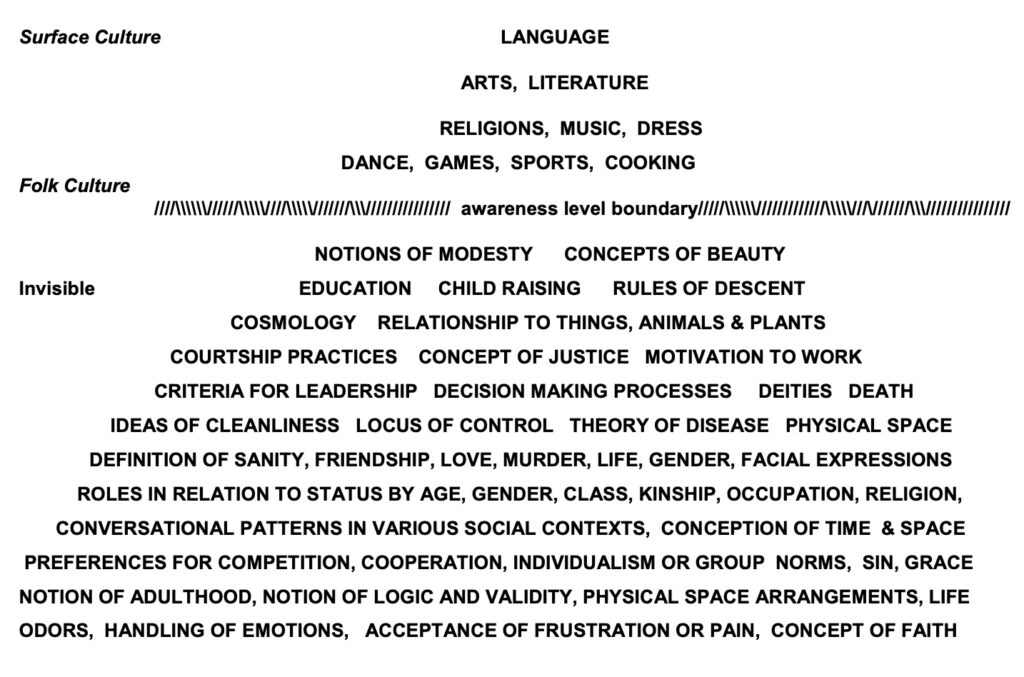Business Imprint
Iceberg Model of Culture: A Guide to Visible and Invisible Cultural Aspects
Just as an iceberg mainly lies below the surface, the most substantial parts of culture are not immediately visible. Let’s dive into the Iceberg Model of Culture to better understand this concept.
The Iceberg Model of Culture is a widely used analogy. This model is comparable to an iceberg which is divided into two sections – the visible part (cultural elements we consciously recognize) and the substantially larger invisible part (cultural aspects that remain hidden or unconscious to us).
Thus, we can say culture involves both aspects that are readily apparent (elements of culture we are familiar with) and those that are more elusive, being things we sense, guess at, or infer (parts of the culture we are less alert to).
Just as with an iceberg, the observable parts of a culture only represent a tiny fraction, the rest lies beneath the surface. A more comprehensive understanding of culture is only achievable when we delve deeper, exploring those elements below the surface layer.
Furthermore, this iceberg or onion analogy is of paramount importance when looking at behaviors, beliefs, values, norms, and cognitive patterns in a cultural context.
Iceberg Model of Culture
Source: ResearchGate
The “Iceberg Model of Culture“, introduced by Edward T. Hall in 1976, is a metaphor that likens the characteristics of an organizational culture to that of an iceberg floating in the frosty waters of the Arctic.

Much like an iceberg where a mere 10% is visible above the waters, the majority of it lies beneath the surface. This phenomenon is often referred to as the “iceberg effect.”
Similarly, in an organization, the actual visibility of its culture is indeed minor compared to its substantial magnitude and significance.
Going beyond the “surface culture,” the core of a powerful culture is often rooted in the organization’s values and beliefs. This foundational culture, known as “deeper culture,” usually remains unseen to the external observer.
But remember, the essence of culture surpasses the bounds of just workplace attire or mannerisms; it extensively encompasses individual beliefs and the way people engage with one another.
Why Iceberg, not Something Else?
Only a small portion of an iceberg’s bulk surfaces above the waterline.
Similarly, when it comes to cultural elements like clothing, appearance, language, manners, greeting rituals, and forms of art and music, we only discern a minor part of an individual’s culture on initial contact.
Nevertheless, such impressions serve as just the tip of the iceberg, highlighting a small segment of the person’s entire cultural identity. Just like a physical iceberg, a cultural iceberg has significant attributes dwelling beneath the obvious surface.
Defining Core Values
The metaphor of a cultural iceberg emphasizes numerous essential facets concealed below the ostensible layer. These hidden elements include personal thoughts, preferences, and priorities, culminating in the individual’s attitudes and values.
These fundamental values of a culture encapsulate the general consensus on what is deemed morally right and wrong. It also covers the behavioral norms which are regarded as appropriate and inappropriate within the community.
Key values like honesty, respect, and integrity are imparted to both young and old in the society. However, the way these values are expressed or interpreted can significantly vary depending on different circumstances.
Interpreting Core Values
Understanding the depth of your core values could be more complex than it appears at surface level.
These values are extrapolated from observable day-to-day behaviors; the kind of language people use, the tone they adopt while speaking, the laws that they abide by, and how they interact with others all help to clarify their underlying values.
Observations made in different settings such as the workplace, can shed light on these core standards.
Modifying Core Values
Many of us embed our core values during our early years, but it’s also true that these values can alter over time.
Exposure to new experiences or shifts in cultural norms can lead to a change in deep-seated values.
Yet, be aware that these changes to foundational beliefs are not always an easy or swift process. The outward perception of a culture can be based on several traditional values.
If a person is part of a cultural group, their values are often influenced by traditions handed down over generations.
Culturally shaped norms are influenced by a host of factors – a person’s family and educational background, media exposure, enacted laws, and so forth. All these elements shape a person’s world view and what they hold to be of vital importance.
Exploring the Cultural Iceberg
There are aspects of culture which are easily discernible to the observant eye.
However, gaining a nuanced understanding of entrenched beliefs requires additional exploration. This might involve studying the cultural influences that shape values, reflecting on one’s own values, or inquiring about the values of others.
Staying open to the fact that individuals might hold different values is an integral part of this process.
Examples of the Iceberg Model of Culture
Cultures within organizations comprise both perceptible and concealed components.
It is common for the public to be cognizant of a company’s mission and activities. However, akin to an iceberg, organizations are driven by unseen behaviors. Therefore, leaders need to venture beyond surface-level issues like rampant employee turnover or inadequate employee engagement.
Aspects like employee resistance to change, or incongruity between a company’s culture and its strategy, warrant more extensive scrutiny.
Observable Elements
In employing the Iceberg Model, start by examining observable cultural practices or events.
For instance, when an individual from one culture ventures into another, differences in attire, cuisine, living habits, and greetings can induce cultural shock. These cultural variances can provide a deeper understanding of people and their behavior.
Ideas and Mindsets
The fact is, we all harbor some self-perceptions that we know are misaligned with the truth. Regardless of whether these notions pertain to ourselves or to the larger world, they can induce feelings of stress, anxiety, or frustration.
Patterns and Habits of Employees
According to the Iceberg Model of Culture, individuals tend to behave in certain predictable ways. Being able to discern these patterns can smooth collaborative efforts or facilitate necessary changes.
Consider a scenario where an organization’s employees are regularly late, leaving the team leader puzzled. A deeper examination revealed a recurring cause: daily late-night meetings, often exceeding the stipulated duration, resulted in tardiness the following morning.
By identifying the pattern, the team leader was able to address the issue, adjusting the meeting schedule to an earlier slot in the morning, thus enabling employees to leave work on time.
Culture Mirroring the Iceberg Theory
Ever wondered why culture is likened to an iceberg? Could it be our innate curiosity towards different cultures?
- Or perhaps culture, at times, seems like it’s submerged in an overwhelming ocean of human emotions? Does it stem from the perceived downfall of cultural values, like the sinking of the Titanic?
- Not at all! The comparison arises from their shared characteristic of visibility. Just like icebergs, which are famously massive yet revealing only 10% of their bulk above water, the same can be said about culture. Approximately 90% of it stays unseen, lurking beneath.
- There’s more commonality here than you might think. When trying to understand culture, you’ll find that you can initially perceive around 10% of it. However, to truly get the big picture, you need to explore deeper. This concept was formulated in the 1970s by Anthropologist Edward T. Hall, who contributed significantly to our contemporary understanding of culture. Hall’s paradigm has profoundly widened our comprehension of human society.
Contrast Between Visible & Invisible Aspects of the Cultural Iceberg
You can think of your initial interaction with a new culture, whether attained via travel or through other experiences, as you spotting the tip of the cultural iceberg. This is what the top ten percent represents.
- You visually access culture via food, language, music, traditional games and celebrations, and artworks. They’re like the tip of the iceberg, above water for everyone to see.
- These details matter significantly. They shape the way cultures unify and communicate. They are, however, susceptible to shifts over time. From culinary recipes to artistic expressions to games, elements of culture can and do evolve.
- Just as language adapts over time, so does the visible ten percent of cultural elements. Even though they could pose less of an emotional burden compared to other parts of culture, these components still matter deeply to people. Their amendments, however, won’t necessarily spark drastic shifts in the overall culture or subsequently people’s perceptions of their identities.
Unseen Parts of Culture
Then we have the invisible or unseen aspects of culture, the elements beneath the water’s surface, like an iceberg. These might include non-verbal communication, our collective expression and management of emotions, and our shared perception of personal space, beauty, and basic etiquette.
To an outsider, these facets could be hard to identify or understand as they’re not clearly visible or stated. They also carry a heavier emotional weight. When these values experience changes, people may feel like their cultural identity is at risk.
Sources
- Coscia M, Arriaga CG. The cultural iceberg. Argentinian Journal of Applied Linguistics-ISSN 2314-3576. 2015;3(2):91-103.
- Schuppli C, Van Schaik CP. Animal cultures: how we’ve only seen the tip of the iceberg. Evolutionary Human Sciences. 2019 Jan;1:e2.
- Sasu A. The cultural iceberg and other cultural models. Buletinul Științific al Universității Tehnice de Construcții București Seria: Limbi Străine și Comunicare. 2016;9(2):79-87.
-

 Manage Your Business2 days ago
Manage Your Business2 days agoTOP 10 VoIP providers for Small Business in 2024
-
Edtech2 days ago
How to fix PII_EMAIL_788859F71F6238F53EA2 Error
-

 Grow Your Business6 days ago
Grow Your Business6 days agoThe Average Size of Home Office: A Perfect Workspace
-
Solution Review6 days ago
Top 10 Best Fake ID Websites [OnlyFake?]
-

 Gaming Technologies4 days ago
Gaming Technologies4 days agoHow to Set Up Text-to-Speech for Channel Points on Twitch





